A Data-Driven Model for Spatial Shallow Landslide Probability of Occurrence Due to a Typhoon in Ningguo City, Anhui Province, China
Abstract
:1. Introduction
2. Geological Background
3. Data and Methods
3.1. Data
3.2. Methods
4. Results and Analysis
4.1. Landslide Database
4.2. Analysis of Factors Influencing the Landslides
4.3. Calculation of Landslide Probability
4.4. Probability of Landslides under Different Rainfall Conditions
5. Discussion
5.1. Landslide Interpretation
5.2. Research on Real Probability Based on the Bayesian Method
6. Conclusions
Author Contributions
Funding
Data Availability Statement
Acknowledgments
Conflicts of Interest
References
- Jiao, F. Analysis of Energy Evolution Characteristics and Transformation Mechanism of Typhoon “Mujigae” (2015) in the Process of Offshore and Landing. Ph.D. Thesis, Nanjing University of Information Science & Technology, Nanjing, China, 2021. [Google Scholar]
- Wang, L.; Luo, Y.; Xu, L.Y.; Zhang, Q.; Chen, Y.; Ye, D.X. Review of Typhoon and Its Related Natural Disasters over the Past 35 Years in China. Sci. Technol. Rev. 2006, 24, 23–25. (In Chinese) [Google Scholar]
- Liu, D.; Liang, P.; Xie, B. Typhoon disaster in China: Prediction, prevention, and mitigation. Nat. Hazards 2009, 49, 421–436. [Google Scholar] [CrossRef]
- Borghuis, A.; Chang, K.; Lee, H. Comparison between automated and manual mapping of typhoon-triggered landslides from SPOT-5 imagery. Int. J. Remote Sens. 2007, 28, 1843–1856. [Google Scholar] [CrossRef]
- Yin, K.; Chen, L.C.; Zhang, G. Regional landslide hazard warning and risk assessment. Earth Sci. Front. 2007, 14, 85–93. [Google Scholar] [CrossRef]
- Xu, J.; Li, W. Characteristics of Rainfall for Typhoon Rainstorm Induced Geological Hazards. Meteorol. Mon. 2009, 35, 42–48. (In Chinese) [Google Scholar]
- Cui, Y.; Hu, J.; Xu, C.; Zheng, J.; Wei, J. A catastrophic natural disaster chain of typhoon-rainstorm-landslide-barrier lake-flooding in Zhejiang Province, China. J. Mt. Sci. 2021, 18, 2108–2119. [Google Scholar] [CrossRef]
- Xiang, C.; Zhao, H.; Liu, Q.; Dong, L. The distribution of torrential rain after landfalling of Typhoon “Lekima” (1909). J. Meteorol. Sci. 2020, 40, 294–302. (In Chinese) [Google Scholar]
- Dahal, R.K.; Hasegawa, S.; Nonomura, A.; Yamanaka, M.; Masuda, T.; Nishino, K. Failure characteristics of rainfall-induced shallow landslides in granitic terrains of Shikoku Island of Japan. Environ. Geol. 2009, 56, 1295–1310. [Google Scholar] [CrossRef]
- Greco, R.; Giorgio, G.; Capparelli, G.; Versace, P. Early warning of rainfall-induced landslides based on empirical mobility function predictor. Eng. Geol. 2013, 153, 68–79. [Google Scholar] [CrossRef]
- Gutierrez-Martin, A. A GIS-physically-based emergency methodology for predicting rainfall-induced shallow landslide zonation. Geomorphology 2020, 359, 107121. [Google Scholar] [CrossRef]
- Althuwaynee, O.F.; Pradhan, B.; Ahmad, N. Estimation of rainfall threshold and its use in landslide hazard mapping of Kuala Lumpur metropolitan and surrounding areas. Landslides 2015, 12, 861–875. [Google Scholar] [CrossRef]
- Segoni, S.; Piciullo, L.; Gariano, S.L. A review of the recent literature on rainfall thresholds for landslide occurrence. Landslides 2018, 15, 1483–1501. [Google Scholar] [CrossRef]
- Teja, T.S.; Dikshit, A.; Satyam, N. Determination of rainfall thresholds for landslide prediction using an algorithm-based approach: Case study in the Darjeeling Himalayas, India. Geosciences 2019, 9, 302. [Google Scholar] [CrossRef] [Green Version]
- Cui, Y.; Bao, P.; Xu, C.; Ma, S.; Zheng, J.; Fu, G. Landslides triggered by the 6 September 2018 Mw 6.6 Hokkaido, Japan: An updated inventory and retrospective hazard assessment. Earth Sci. Inform. 2020, 14, 247–258. [Google Scholar] [CrossRef]
- Cui, Y.; Hu, J.; Zheng, J.; Fu, G.; Xu, C. Susceptibility assessment of landslides caused by snowmelt in a typical loess area in the Yining County, Xinjiang, China. Q. J. Eng. Geol. Hydrogeol. 2022, 55, 1–10. [Google Scholar] [CrossRef]
- Dou, J.; Yunus, A.P.; Tien Bui, D.; Sahana, M.; Chen, C.W.; Zhu, Z.; Wang, W.; Thai Pham, B. Evaluating GIS-based multiple statistical models and data mining for earthquake and rainfall-induced landslide susceptibility using the LiDAR DEM. Remote Sens. 2019, 11, 638. [Google Scholar] [CrossRef] [Green Version]
- Raia, S.; Alvioli, M.; Rossi, M.; Baum, R.; Godt, J.; Guzzetti, F. Improving predictive power of physically based rainfall-induced shallow landslide models: A probabilistic approach. Geosci. Model Dev. 2014, 7, 495–514. [Google Scholar] [CrossRef] [Green Version]
- Capparelli, G.; Versace, P. FLaIR and SUSHI: Two mathematical models for early warning of landslides induced by rainfall. Landslides 2011, 8, 67–79. [Google Scholar] [CrossRef]
- Dou, J.; Yunus, A.P.; Bui, D.T.; Merghadi, A.; Sahana, M.; Zhu, Z.; Chen, C.W.; Khosravi, K.; Yang, Y.; Pham, B.T. Assessment of advanced random forest and decision tree algorithms for modeling rainfall-induced landslide susceptibility in the Izu-Oshima Volcanic Island, Japan. Sci. Total Environ. 2019, 662, 332–346. [Google Scholar] [CrossRef]
- Vasu, N.N.; Lee, S.R.; Pradhan, A.M.S.; Kim, Y.T.; Kang, S.H.; Lee, D.H. A new approach to temporal modelling for landslide hazard assessment using an extreme rainfall induced-landslide index. Eng. Geol. 2016, 215, 36–49. [Google Scholar] [CrossRef]
- Zheng, J.; Zou, Z. Environmental geological characteristics of the mountainarea of southern Anhui Province and treatment of geological disasters due to landslide. J. Hefei Univ. Technol. 2006, 29, 102–105. (In Chinese) [Google Scholar]
- Shao, X.; Xu, C.; Ma, S.; Xu, X.; Shyu, J.B.H.; Zhou, Q. Calculation of landslide occurrence probability in Taiwan region under different ground motion conditions. J. Mt. Sci. 2021, 18, 1003–1012. [Google Scholar] [CrossRef]
- Dai, F.; Xu, C.; Yao, X.; Xu, L.; Tu, X.; Gong, Q. Spatial distribution of landslides triggered by the 2008 Ms 8.0 Wenchuan earthquake, China. J. Asian Earth Sci. 2011, 40, 883–895. [Google Scholar] [CrossRef]
- Shao, X.; Ma, S.; Xu, C.; Zhou, Q. Effects of sampling intensity and non-slide/slide sample ratio on the occurrence probability of coseismic landslides. Geomorphology 2020, 363, 107222. [Google Scholar] [CrossRef]
- Xu, C.; Shen, L.; Wang, G. Soft computing in assesment of earthquake-triggered landslide susceptibility. Environ. Earth Sci. 2016, 75, 767. [Google Scholar] [CrossRef]
- Dhakal, A.S.; Sidle, R.C. Distributed simulations of landslides for different rainfall conditions. Hydrol. Processes 2004, 18, 757–776. [Google Scholar] [CrossRef]
- Dou, J.; Yamagishi, H.; Xu, Y.; Zhu, Z.; Yunus, A.P. Characteristics of the torrential rainfall-induced shallow landslides by Typhoon Bilis, in July 2006, using remote sensing and GIS. In GIS Landslide; Springer: Tokyo, Japan, 2017; pp. 221–230. [Google Scholar]
- Shao, X.; Ma, S.; Xu, C.; Xu, X. Effects of raster resolution on real probability of landslides. Remote Sens. Appl. Soc. Environ. 2020, 19, 100364. [Google Scholar] [CrossRef]
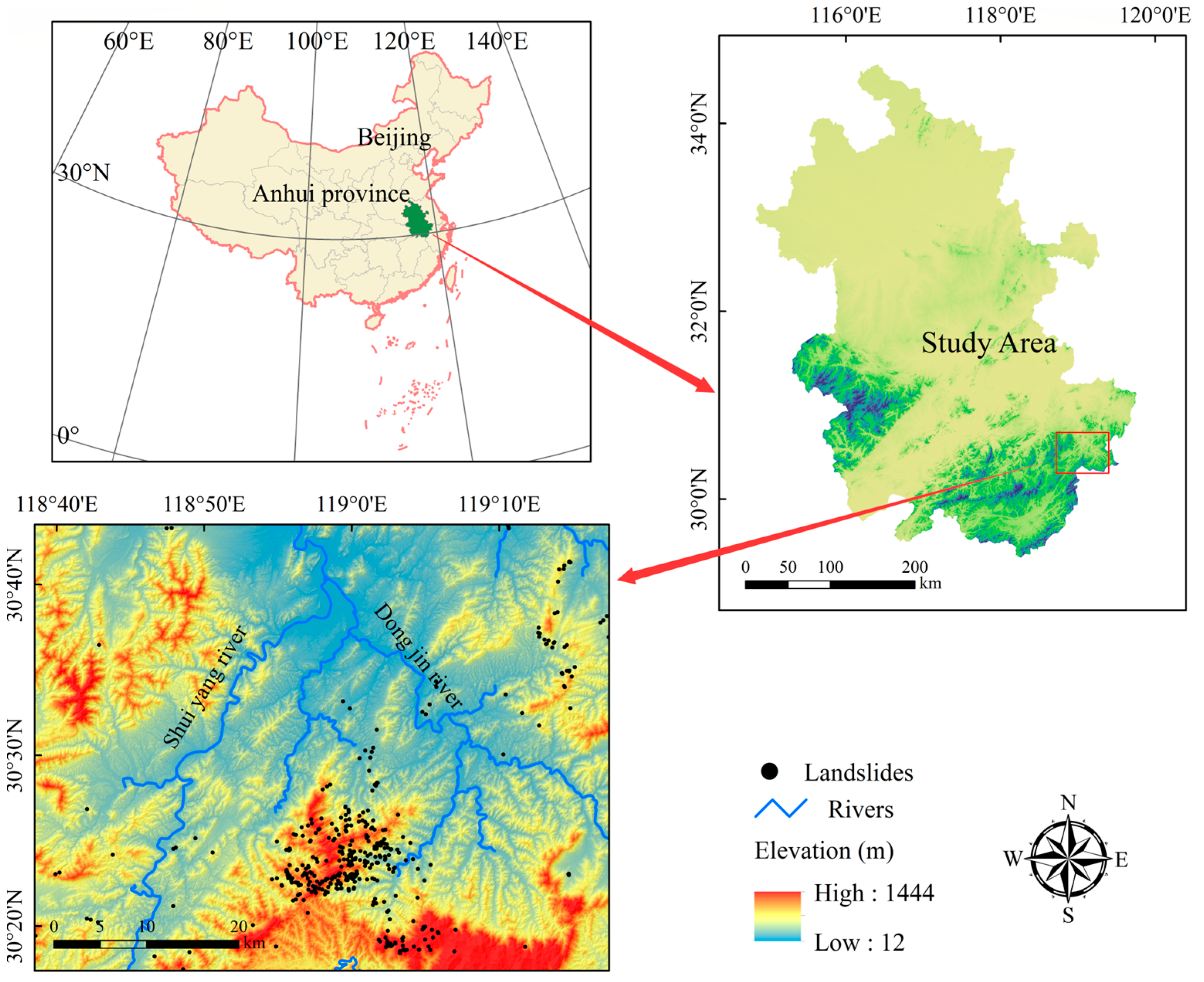
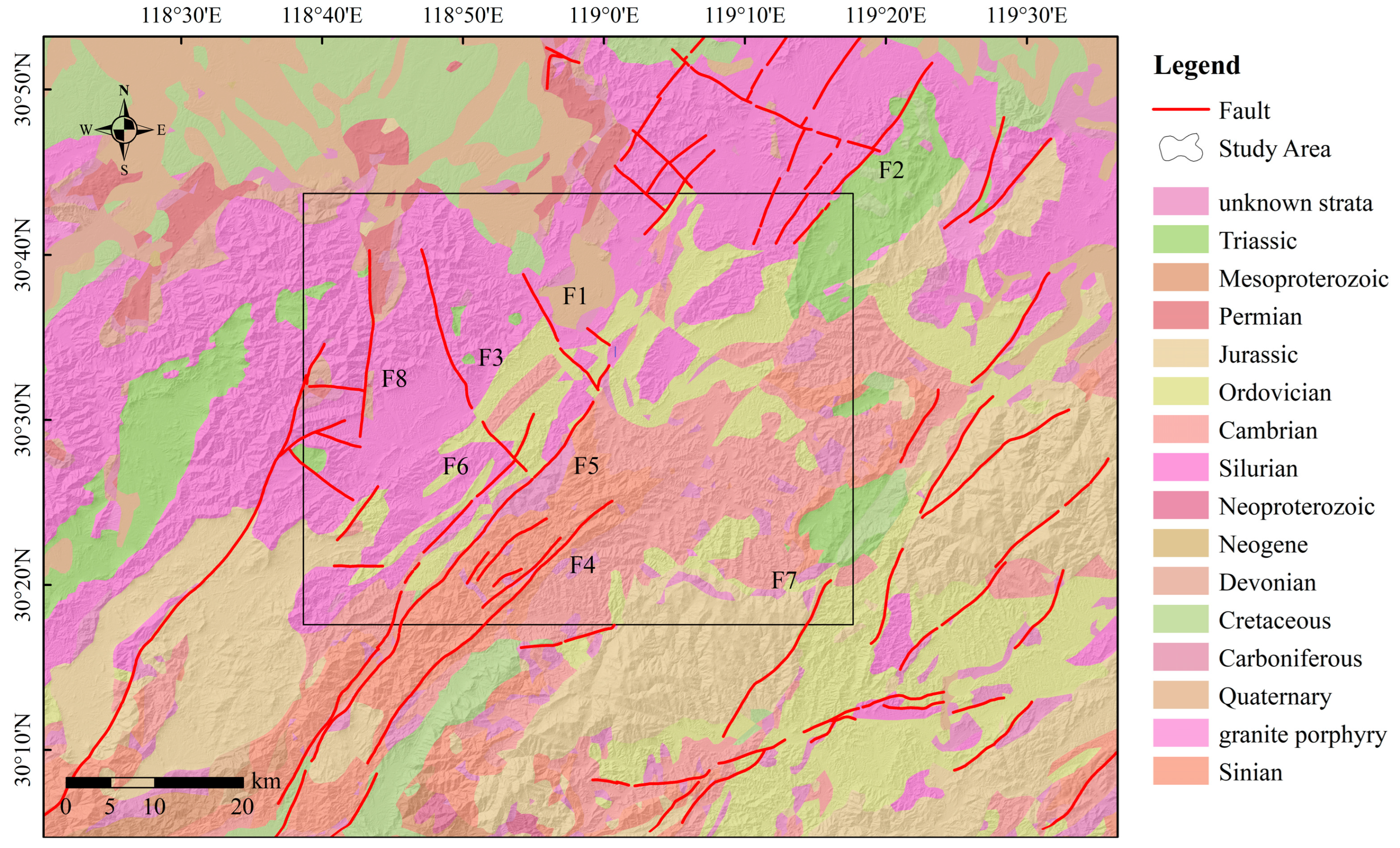
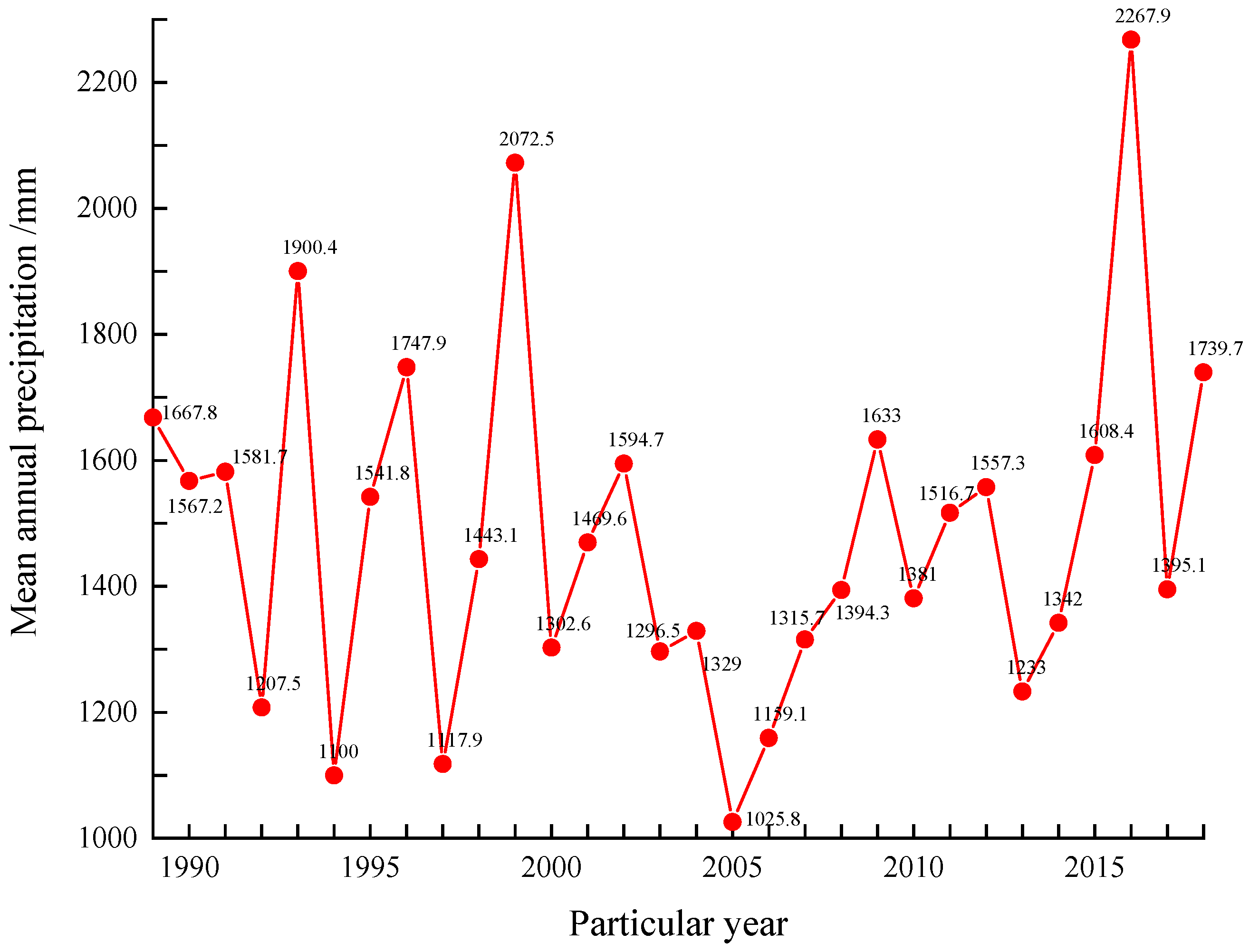
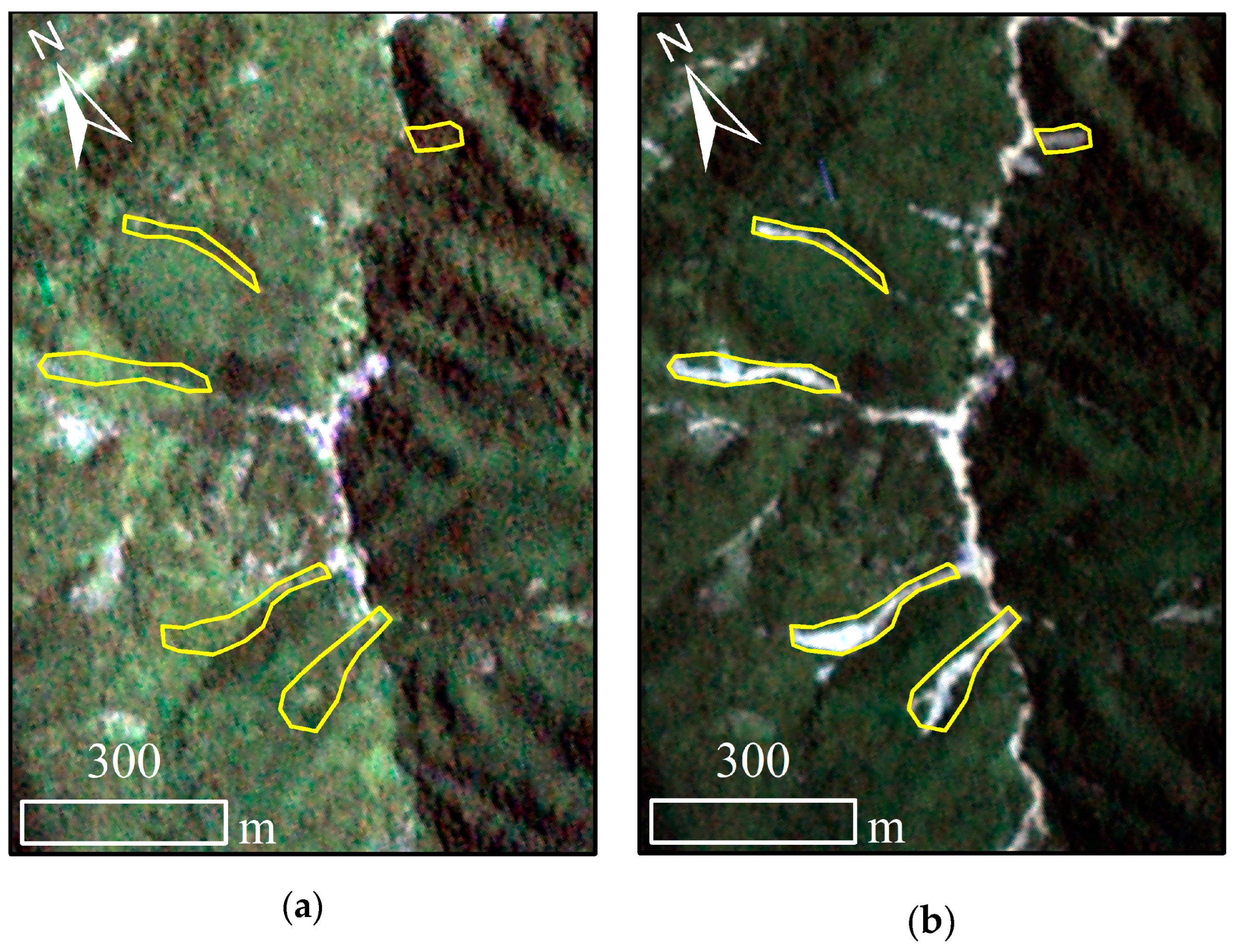

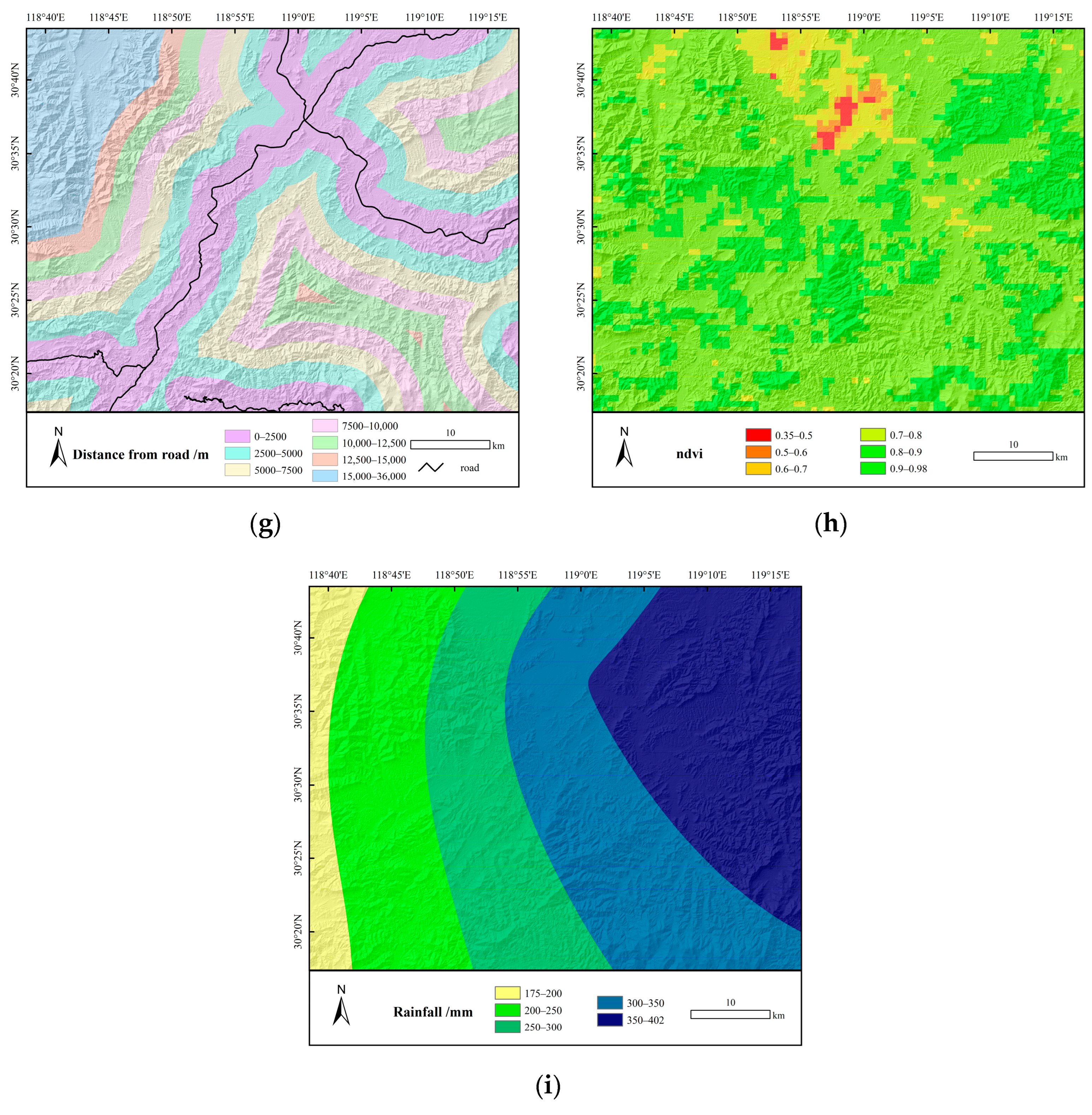


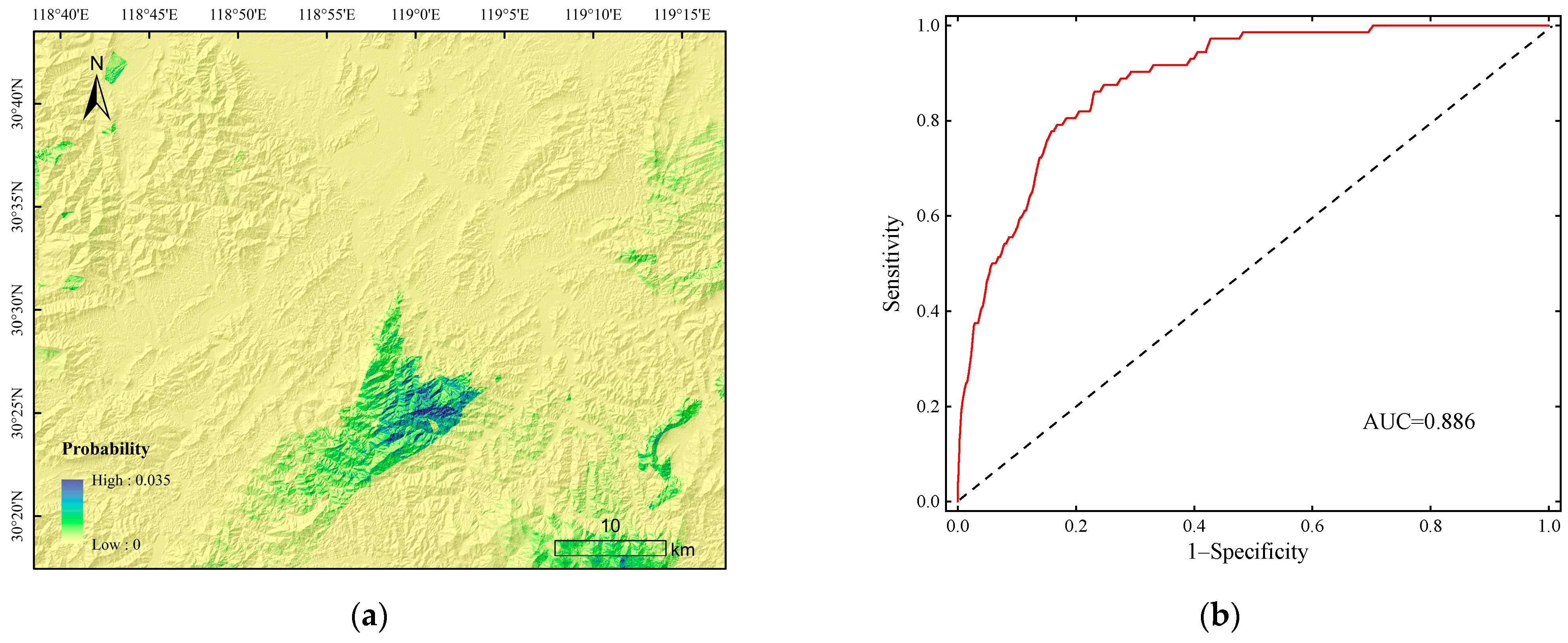
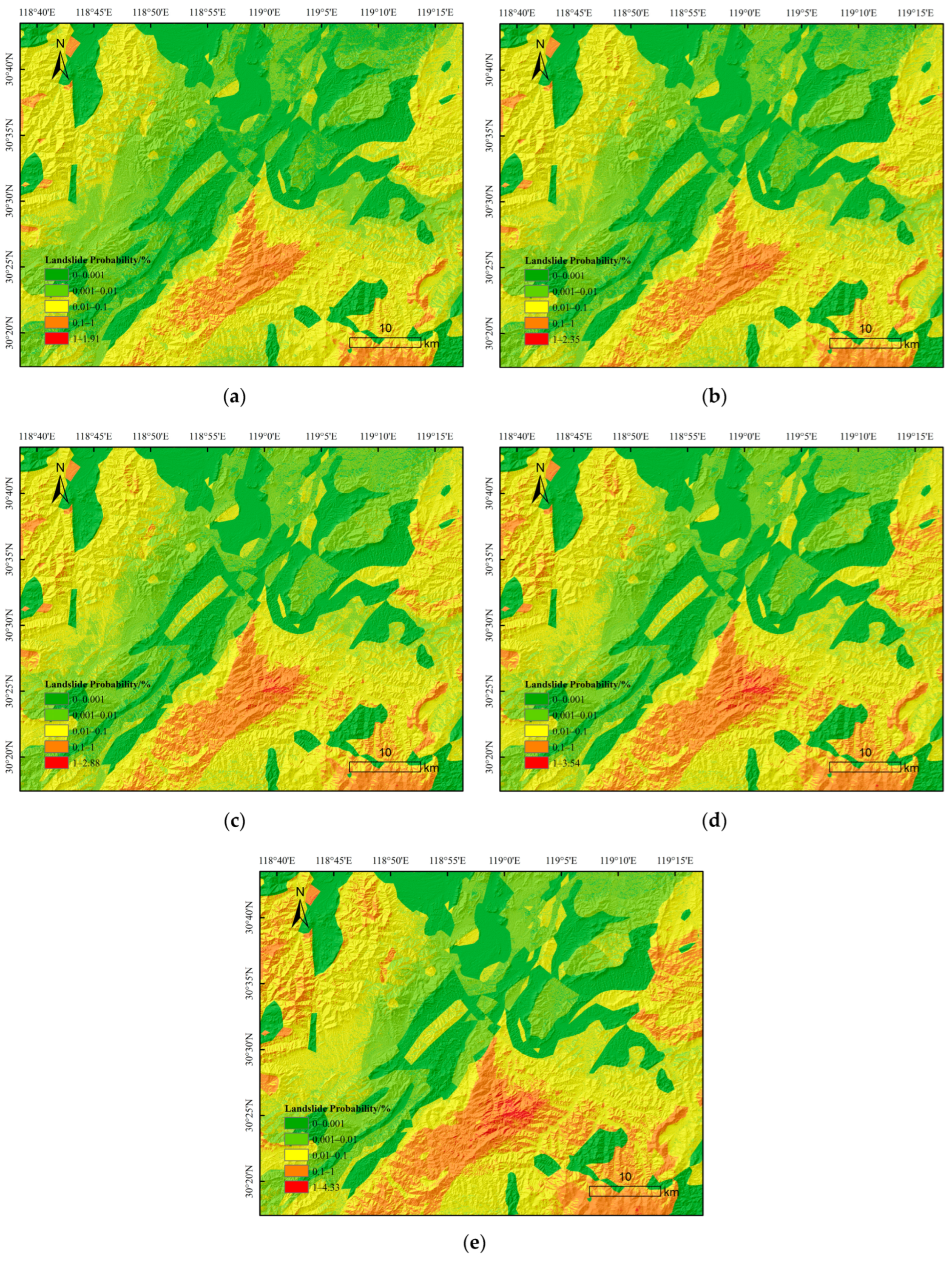

| Landslide Area Zones (m2) | 0–2000 | 2000–5000 | 5000–10,000 | 10,000–20,000 | 20,000–50,000 |
|---|---|---|---|---|---|
| Number of landslides | 197 | 149 | 50 | 11 | 7 |
| Proportion of landslides (%) | 47.6 | 36 | 12.1 | 2.6 | 1.7 |
| Landslide area (km2) | 0.25 | 0.45 | 0.34 | 0.14 | 0.24 |
| Proportion of landslide area (%) | 17.6 | 31.7 | 23.9 | 9.9 | 16.9 |
| Influencing Factors | Classification Standard | Type |
|---|---|---|
| Elevation (m) | 1. 12–250; 2. 250–500; 3. 500–750; 4. 750–1000; 5. 1000–1250; 6. 1250–1444 | Continuous |
| Slope (°) | 1. 0–10; 2. 10–20; 3. 20–30; 4. 30–40; 5. 40–50; 6. 50–80 | Continuous |
| Aspect | 1. N (0–22.5, 337.5–360); 2. NE (22.5–67.5); 3. E (67.5–112.5); 4.SE (112.5–157.5); 5. S (157.5–202.5); 6. SW (202.5–247.5); 7. W (247.5–292.5); 8. NW (292.5–337.5); 9. Flat (−1) | Classification |
| Distance to faults (m) | 1. 0–1000; 2. 1000–2000; 3. 2000–3000; 4. 3000–4000; 5. 4000–5000; 6. 5000–10,000 | Continuous |
| Strata | 1. unknown strata; 2. Ordovician (O); 3. Cambrian (∈); 4. Triassic (T); 5. Sinian (Z); 6. Silurian (S); 7. Jurassic (J); 8. Cretaceous (K); 9. Quaternary (Qp); 10. Permian (P); 11. Devonian (D); 12. Carboniferous (C); 13. granite porphyry (γπ) | Classification |
| Distance to rivers (m) | 1. 0–1500; 2. 1500–3000; 3. 3000–4500; 4. 4500–6000; 5. 6000–7500; 6. 7500–9000; 7. 9000–31,000 | Continuous |
| Distance to roads (m) | 1. 0–2500; 2. 2500–5000; 3. 5000–7500; 4. 7500–10,000; 5. 10,000–12,500; 6. 12,500–15,000; 7. 15,000–36,000 | Continuous |
| NDVI | 1. 0.35–0.5; 2. 0.5–0.6; 3. 0.6–0.7; 4. 0.7–0.8; 5. 0.8–0.9; 6. 0.9–0.98 | Continuous |
| 3 days rainfall (mm) | 1. 175–200; 2. 200–250; 3. 250–300; 4. 300–350; 5. 350–402 | Continuous |
| Factors | Type | Classification | Weights |
|---|---|---|---|
| Elevation | Continuous | 0.166 | |
| Slope | Continuous | 0.195 | |
| Rainfall | Continuous | 0.211 | |
| NDVI | Continuous | −0.274 | |
| Distance to faults | Continuous | 0.134 | |
| Distance to rivers | Continuous | 0.05 | |
| Distance to roads | Continuous | 0.486 | |
| Aspect | Classification | 1 | 0 |
| 2 | 0.931 | ||
| 3 | 1.004 | ||
| 4 | 1.402 | ||
| 5 | 1.014 | ||
| 6 | 1.201 | ||
| 7 | 0.926 | ||
| 8 | 0.186 | ||
| 9 | −11.167 | ||
| Strata | Classification | 1 | 0 |
| 2 | −13.156 | ||
| 3 | −0.141 | ||
| 4 | −0.232 | ||
| 5 | 1.448 | ||
| 6 | −2.043 | ||
| 7 | 0.41 | ||
| 8 | −13.589 | ||
| 9 | −13.821 | ||
| 10 | −14.688 | ||
| 11 | −14.631 | ||
| 12 | −14.861 | ||
| 13 | −14.328 |
Publisher’s Note: MDPI stays neutral with regard to jurisdictional claims in published maps and institutional affiliations. |
© 2022 by the authors. Licensee MDPI, Basel, Switzerland. This article is an open access article distributed under the terms and conditions of the Creative Commons Attribution (CC BY) license (https://creativecommons.org/licenses/by/4.0/).
Share and Cite
Cui, Y.; Jin, J.; Huang, Q.; Yuan, K.; Xu, C. A Data-Driven Model for Spatial Shallow Landslide Probability of Occurrence Due to a Typhoon in Ningguo City, Anhui Province, China. Forests 2022, 13, 732. https://doi.org/10.3390/f13050732
Cui Y, Jin J, Huang Q, Yuan K, Xu C. A Data-Driven Model for Spatial Shallow Landslide Probability of Occurrence Due to a Typhoon in Ningguo City, Anhui Province, China. Forests. 2022; 13(5):732. https://doi.org/10.3390/f13050732
Chicago/Turabian StyleCui, Yulong, Jiale Jin, Qiangbing Huang, Kang Yuan, and Chong Xu. 2022. "A Data-Driven Model for Spatial Shallow Landslide Probability of Occurrence Due to a Typhoon in Ningguo City, Anhui Province, China" Forests 13, no. 5: 732. https://doi.org/10.3390/f13050732
APA StyleCui, Y., Jin, J., Huang, Q., Yuan, K., & Xu, C. (2022). A Data-Driven Model for Spatial Shallow Landslide Probability of Occurrence Due to a Typhoon in Ningguo City, Anhui Province, China. Forests, 13(5), 732. https://doi.org/10.3390/f13050732







